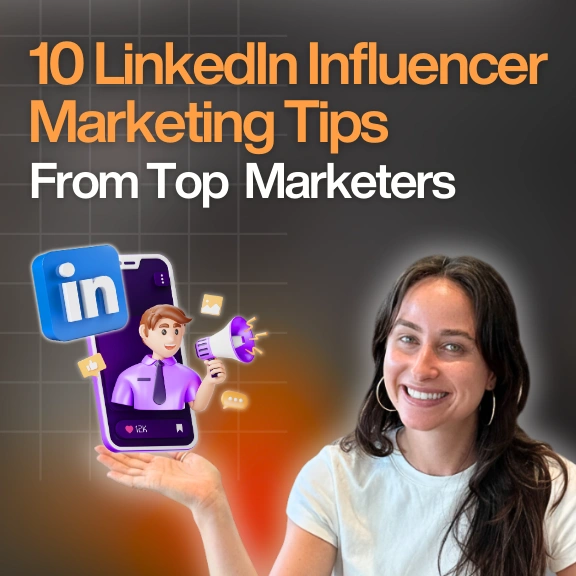Encontre
Faça os movimentos certos para identificar os melhores criadores para sua marca
Envolva-se
Faça campanhas, gerencie criadores e acompanhe os resultados que se relacionam com você
Blog e artigos
Seu recurso definitivo para a economia do criador
Metodologia e classificações
Sobre o Favikon, classificações, ferramentas e muito mais.
Percepções
A receita por trás dos rankings virais e cobiçados da Favikon.
Ferramentas gratuitas para potencializar seus fluxos de trabalho de marketing de influenciadores.
Veja as histórias de sucesso dos usuários do Favikon.
Tenha acesso a todos os rankings da Favikon.
Torne-se um parceiro
Torne-se um afiliado
Sobre a equipe por trás do Favikon
O lugar para conversar economia do criador, juntos


Classificações em destaque

Here is the Top 50 Rising Video Creators on LinkedIn. Video is quickly becoming the platform’s most powerful format, with creators gaining more reach and engagement than ever. As Gen Z grows its presence and tools like BrandLink and Thought Leader Ads support content creation, LinkedIn is doubling down on video. This ranking, made in partnership with OpusClip, celebrates the creators leading this shift and aims to inspire anyone ready to start sharing through video.

Here is the Top 50 Rising Video Creators on LinkedIn. Video is quickly becoming the platform’s most powerful format, with creators gaining more reach and engagement than ever. As Gen Z grows its presence and tools like BrandLink and Thought Leader Ads support content creation, LinkedIn is doubling down on video. This ranking, made in partnership with OpusClip, celebrates the creators leading this shift and aims to inspire anyone ready to start sharing through video.
Como calcular a taxa de engajamento de qualquer criador em qualquer mídia social
Saiba como calcular a taxa de engajamento de um criador no Instagram, TikTok, YouTube e muito mais. Descubra fórmulas, ferramentas e dicas para encontrar influenciadores de alto desempenho.
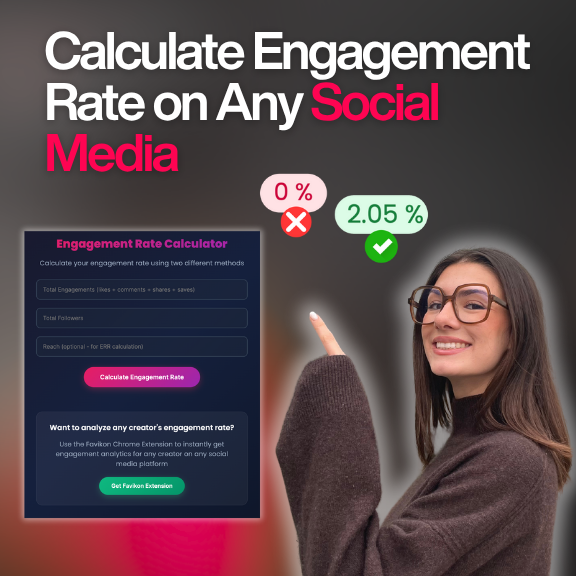


Sarthak Ahuja is a marketing enthusiast currently contributing to digital marketing strategies at Favikon. An alumnus of ESCP Paris with over 2 years of professional experience, he has held multiple marketing roles across industries. Sarthak's work has been published in journals and websites. He loves to read and write about topics concerning sustainability, business, and marketing. You can find him on LinkedIn and Instagram.
Check Brand DealsSe você está realizando campanhas de influenciadores ou procurando criadores para parcerias de marca, você já sabe disso. contagem de seguidores não é tudo. O que realmente importa é o quão ativamente seu público interage com seu conteúdo. Um criador com 50.000 seguidores genuinamente engajados fornecerá resultados muito melhores do que alguém com 500.000 seguidores passivos.
O desafio? A maioria das plataformas de mídia social não torna as taxas de engajamento facilmente visíveis, e calculá-las manualmente para cada parceiro em potencial é demorado. Este guia mostrará exatamente como avalie engajamento do criador em todas as principais plataformas usando fórmulas comprovadas e ferramentas profissionais.
Por que a taxa de engajamento é sua métrica mais importante
Veja o que separa campanhas de influenciadores bem-sucedidas de desastres que esgotam o orçamento: taxa de engajamento correlacionar diretamentes com o desempenho da campanha. Quando o público de um criador curte, comenta, compartilha e salva ativamente seu conteúdo, esses mesmos seguidores têm maior probabilidade de agir em postagens de marca.
Do ponto de vista comercial, a taxa de engajamento diz tudo sobre a qualidade do público. Um alto engajamento indica uma comunidade ativa e confiante que valoriza as recomendações do criador. O baixo engajamento geralmente sinaliza comprados seguidores, relevância em declínio ou baixa adequação entre o público e o criador.
Marcas inteligentes usam a taxa de engajamento como pFiltro primário antes mesmo de considerar as taxas de parceria ou dados demográficos.
Fórmula de taxa de engajamento universal
Embora cada plataforma tenha suas nuances, o cálculo principal permanece consistente no Instagram, TikTok, YouTube e outras redes sociais:
Taxa de engajamento = (Total de engajamentos ÷ Total de seguidores) × 100
Para o total de engajamentos, conte as ações específicas da plataforma:
Instagram: Curtidas + Comentários + Compartilhamentos + SalvosTikTok: Curtidas + Comentários + Compartilhamentos
YouTube: Curtidas + Comentários + Compartilhamentos (para vídeos individuais)LinkedIn: Curtidas + Comentários + Compartilhamentos + ReaçõesTwitter/X: Curtidas + Retuítes + Respostas + Citação de Tweets
Exemplo: Um criador do TikTok com 100.000 seguidores cujo vídeo recente recebeu 8.000 curtidas, 500 comentários e 200 compartilhamentos tem uma taxa de engajamento de: (8.700 ÷ 100.000) × 100 = 8,7%
Considerações específicas da plataforma
Taxas de engajamento no Instagram: O algoritmo do Instagram pondera muito o engajamento precoce, então calcule as taxas com base nas métricas finais de 24 a 48 horas. O engajamento das histórias deve ser monitorado separadamente, pois não contribui para a visibilidade da publicação do feed.
Taxas de engajamento do TikTok: A página “Para você” do TikTok pode criar grandes variações de alcance. Veja o engajamento médio em 10 a 20 vídeos recentes, em vez de postagens virais únicas. Uma taxa de 5 a 10% é excelente no TikTok.
Taxas de engajamento do YouTube: As taxas de engajamento do YouTube geralmente são mais baixas (2 a 3% é bom) porque a plataforma prioriza o tempo de exibição em vez das reações imediatas. Considere a duração da visualização e as proporções entre assinantes e visualizações junto com as métricas de engajamento padrão.
Taxas de engajamento do LinkedIn: O LinkedIn vê taxas de engajamento mais altas (2-5% é forte) devido ao seu ambiente profissional focado em discussões. Os comentários têm mais peso do que as curtidas em campanhas focadas em negócios.
Relatório de referência da taxa de engajamento da Favikon
Curioso para saber como seu engajamento se compara? O relatório de referência da taxa de engajamento da Favikon de 2025 detalha os dados de engajamento por plataforma e tamanho do seguidor. Spoiler: os nanoinfluenciadores (com menos de 10 mil seguidores) superam consistentemente os perfis maiores, com taxas de engajamento muito maiores do que os macro ou mega influenciadores. Se você está no TikTok, Instagram, LinkedIn ou YouTube, este relatório fornece referências claras para avaliar o desempenho do influenciador em todos os setores.
Leia o relatório de referência da taxa de engajamento da Favikon
Como pesquisar as taxas de engajamento de criadores
Método 1: Divulgação direta: Os criadores profissionais mantêm kits de mídia com dados recentes de engajamento. Ao entrar em contato com parceiros em potencial, solicite:
- Taxa média de engajamento nas últimas 30 postagens
- Capturas de tela de análises nativas como verificação
- Detalhamento por tipo de conteúdo (postagens versus histórias versus bobinas)
Método 2: cálculo manual Para perfis públicos, calcule manualmente usando publicações recentes:
- Identificar 10 a 20 postagens recentes
- Registre o total de engajamentos para cada
- Calcule as taxas individuais usando a fórmula acima
- Calcule a média dos resultados para uma taxa básica
Método 3: Ferramentas de pesquisa profissional É aqui que a maioria das agências e marcas economiza tempo significativo e obtém dados mais precisos. Uma das ferramentas que fornecem esses dados é o Favikon. Faça o download do Extensão Favikon Chrome da Chrome Web Store. Em seguida, acesse o perfil de qualquer criador e obtenha rapidamente a taxa de engajamento à direita na extensão Favikon Chrome.
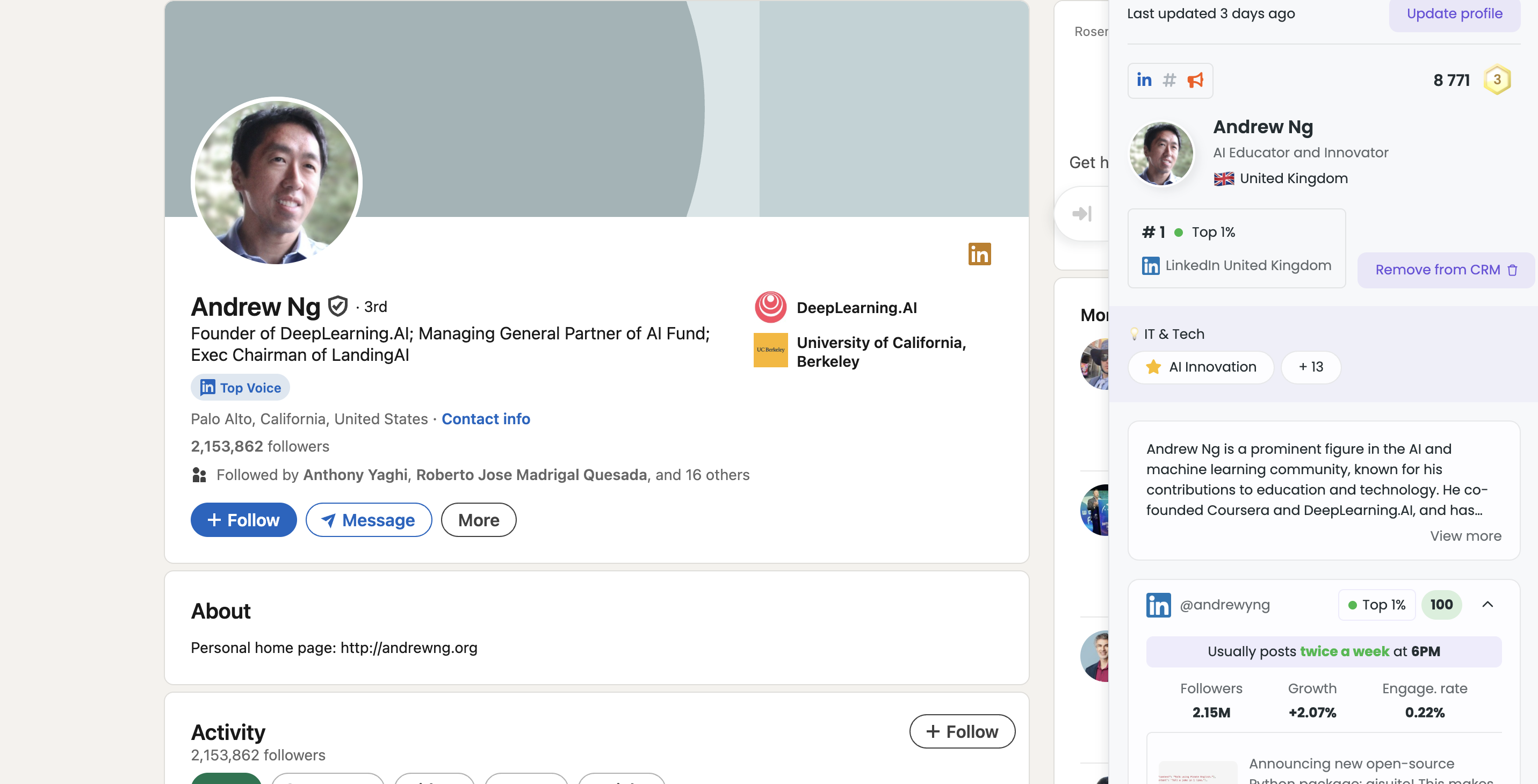
Calculadora de taxa de engajamento gratuita da Favikon
Antes de mergulhar na pesquisa de criadores, você pode calcular rapidamente as taxas de engajamento de qualquer conta de mídia social usando a calculadora de taxa de engajamento gratuita da Favikon. Essa ferramenta fornece cálculos de ERF (taxa de engajamento por seguidores) e ERR (taxa de engajamento por alcance) para Instagram, TikTok, YouTube e outras plataformas.
Basta visitar Calculadora de engajamento gratuita Favikon e insira as métricas de engajamento das postagens recentes de qualquer criador, seus seguidores e alcance. A calculadora mostra instantaneamente se o desempenho deles atende aos padrões do setor, economizando tempo em cálculos manuais.

Estratégias de pesquisa específicas da plataforma
Pesquisa no Instagram: Concentre-se nas postagens do feed para ver o potencial de parceria, mas confira os destaques do Stories para ver exemplos de integração de marcas. Analise o desempenho do IGTV e do Reels separadamente, pois eles atendem a diferentes objetivos de campanha.
Pesquisa TikTok: Analise o uso de hashtags e as tendências de adoção de áudio. Os criadores que usam elementos de tendência de forma eficaz geralmente mantêm taxas de engajamento mais altas e melhor desempenho da campanha.
Pesquisa no YouTube: Analise a qualidade dos comentários e as taxas de resposta do criador. Os criadores do YouTube que interagem ativamente com suas comunidades geralmente oferecem melhores resultados de parceria com a marca.
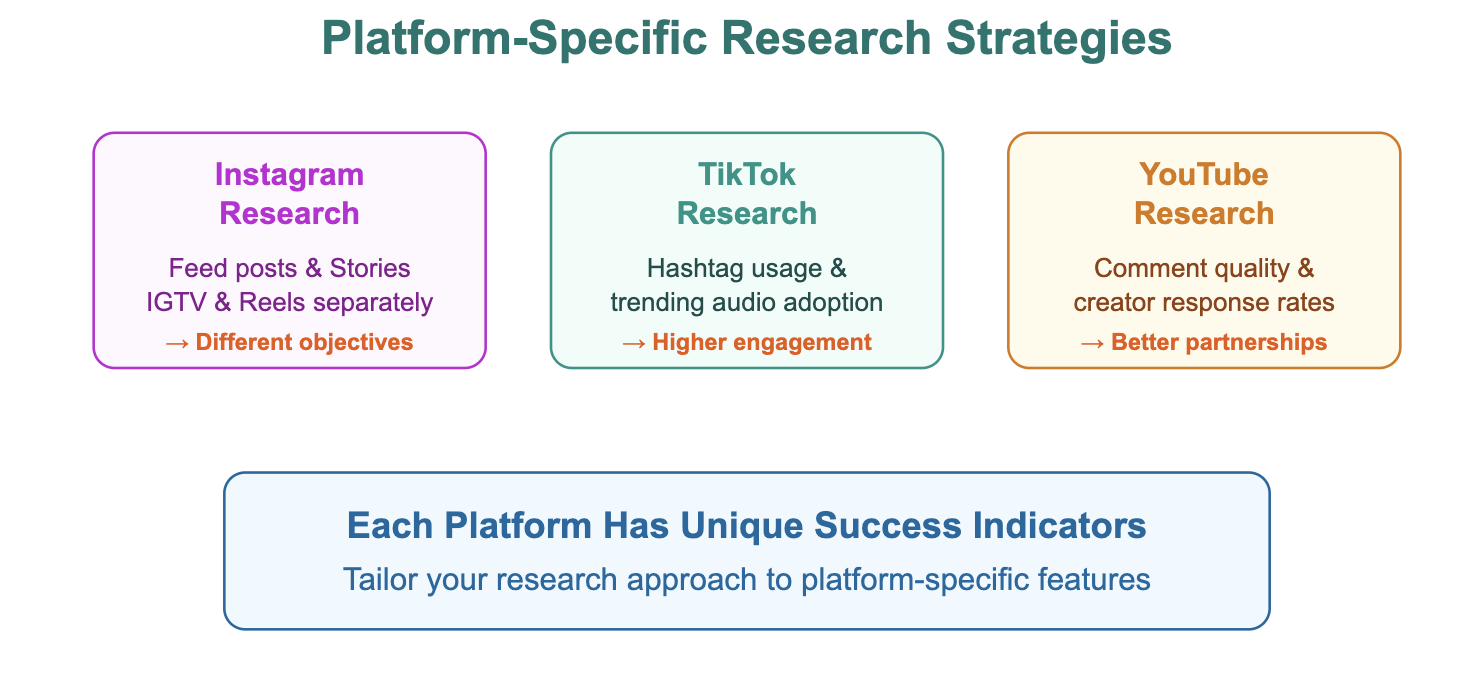
Transformando dados de engajamento em decisões de parceria
Para lançamentos de produtos: Priorize criadores com altas taxas de salvamento e comentários detalhados. Esses públicos têm maior probabilidade de pesquisar e comprar produtos em destaque.
Para reconhecimento da marca: Concentre-se em criadores com altas taxas de compartilhamento e amplo alcance. A taxa de engajamento deve ser equilibrada com o tamanho total do público para máxima exposição.
Para a construção da comunidade: Escolha criadores com seções de comentários ativas e altas taxas de interação entre criadores e público. Essas parcerias criam uma afinidade duradoura com a marca.
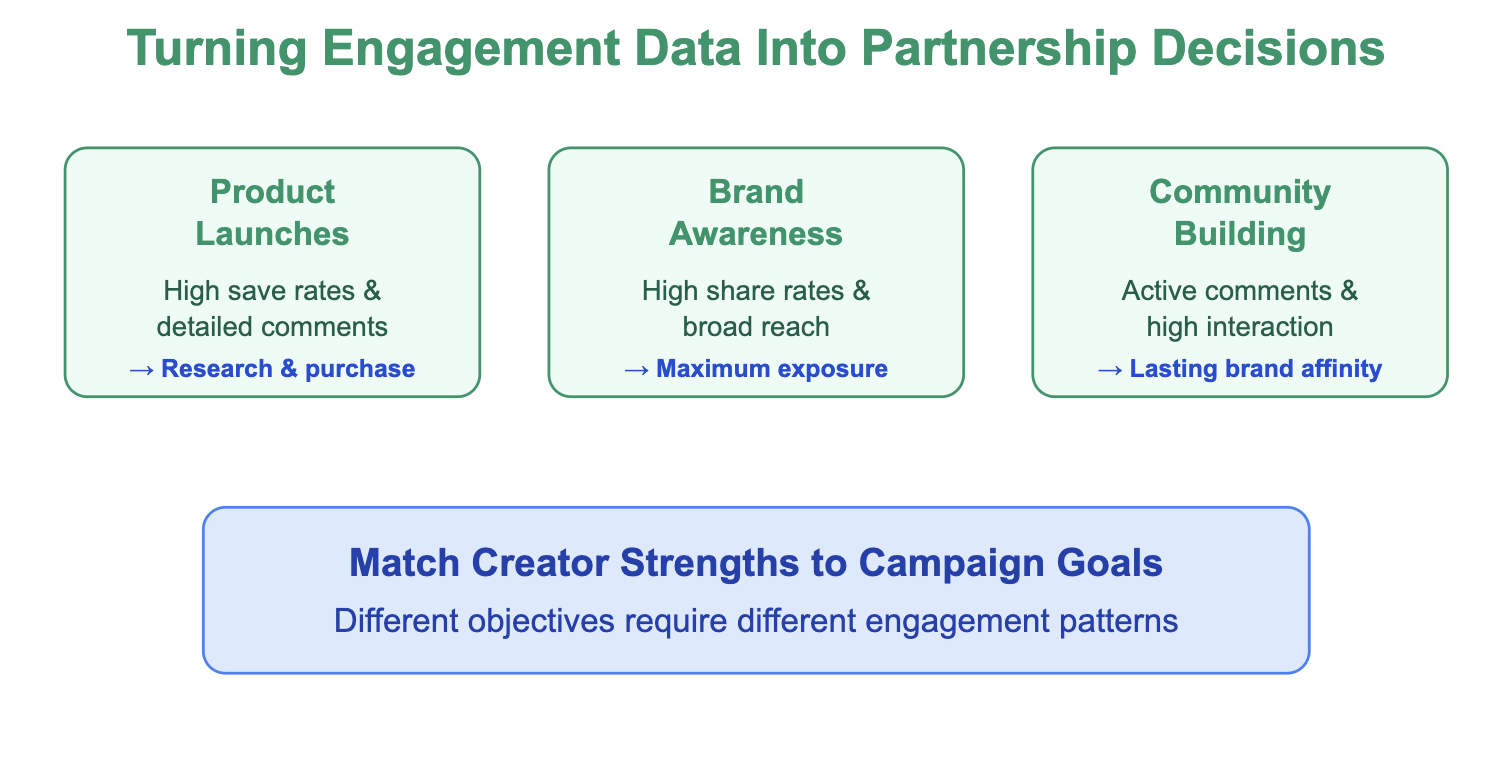
Erros comuns a serem evitados
Supervalorizando o conteúdo viral: Postagens virais únicas podem distorcer os cálculos da taxa de engajamento. Sempre use médias em várias postagens para uma avaliação precisa.
Ignorando a sobreposição de público: Trabalhar com vários criadores que compartilham uma sobreposição significativa de público dilui o impacto da campanha. Use dados de engajamento para identificar públicos complementares em vez de concorrentes.
Concentrando-se apenas no desempenho recente: As taxas de engajamento flutuam com base nas mudanças do algoritmo, nas tendências sazonais e na evolução do conteúdo. Veja as tendências de 3 a 6 meses em vez de capturas instantâneas de um único mês.
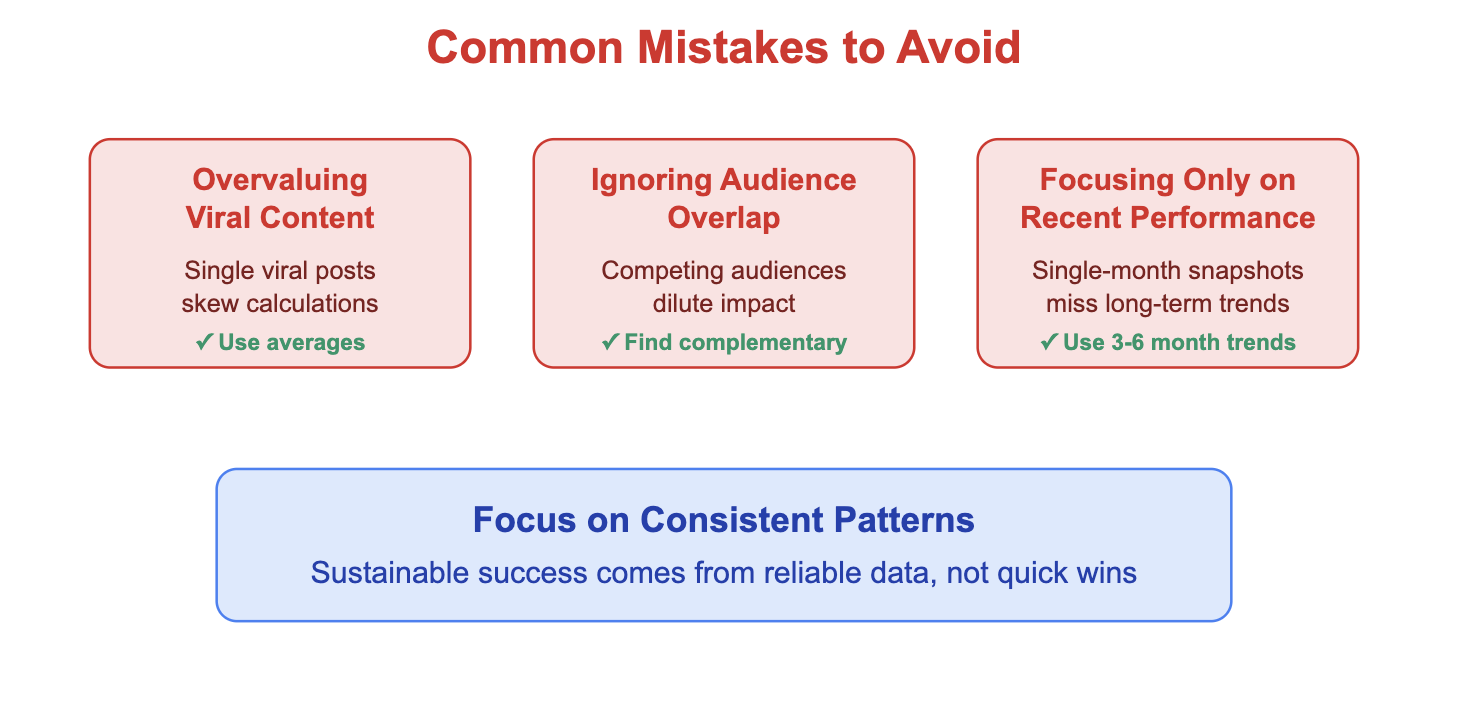
Construindo seu sistema de avaliação de criadores
Crie cartões de pontuação padronizados: Desenvolva critérios consistentes para avaliar os criadores:
- Limites mínimos de taxa de engajamento por plataforma
- Indicadores de qualidade do público
- Alinhamento do conteúdo com os valores da marca
- Consistência histórica do desempenho
Acompanhe a correlação da campanha:Monitore como as taxas de engajamento pré-parceria se correlacionam com o desempenho real da campanha. Esses dados melhoram a precisão da seleção de futuros criadores.
Mantenha bancos de dados de criadores:Documente as taxas de engajamento, as informações do público e o desempenho da campanha dos criadores que você pesquisou. Isso cria inteligência valiosa para futuras campanhas.
Em última análise, a análise da taxa de engajamento consiste em encontrar criadores cujo público confiança suas recomendações são suficientes para agir. Use esses métodos e ferramentas para identificar parceiros que oferecem resultados comerciais reais, não apenas métricas de vaidade impressionantes.
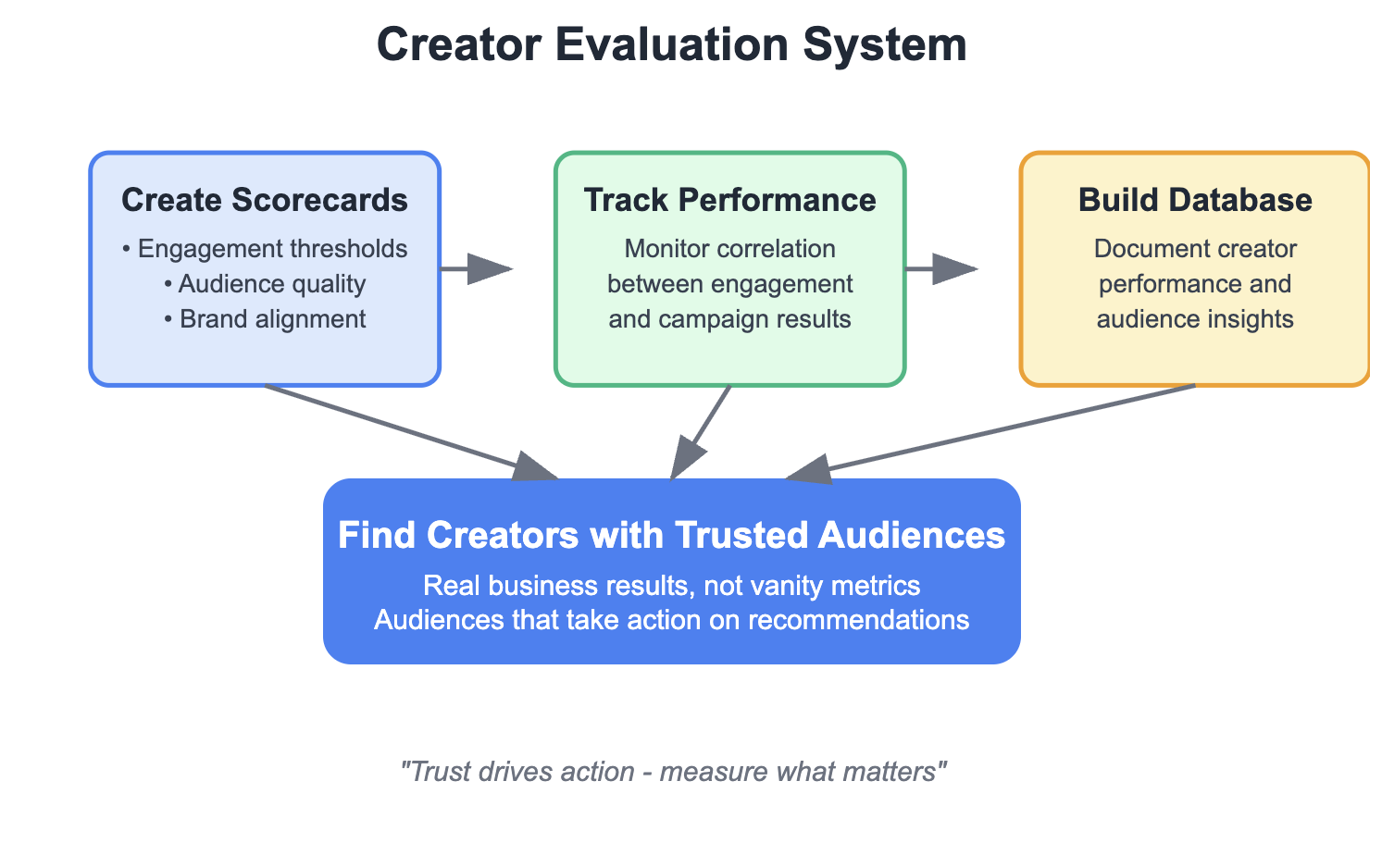
Veja também 👀
O que é uma boa taxa de engajamento nas mídias sociais?
Related Articles
See all the articles










.png)
